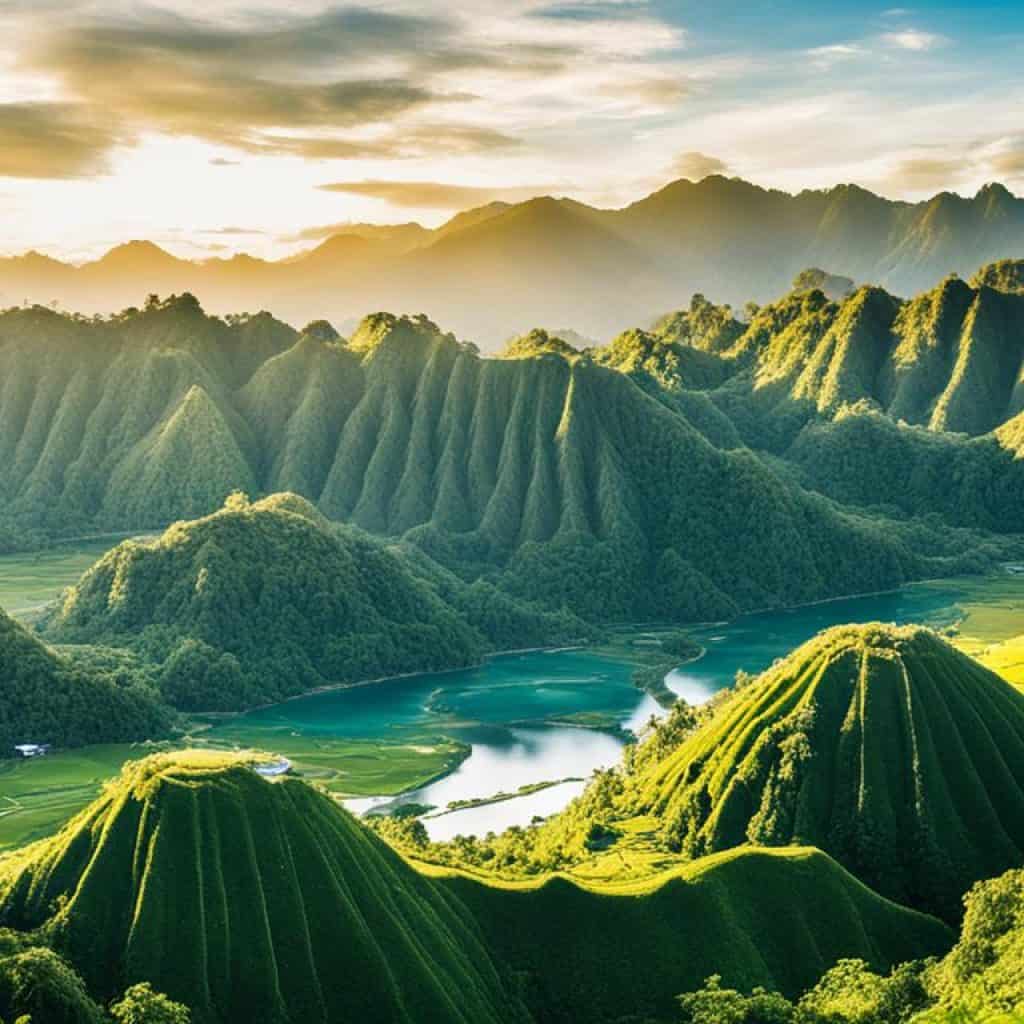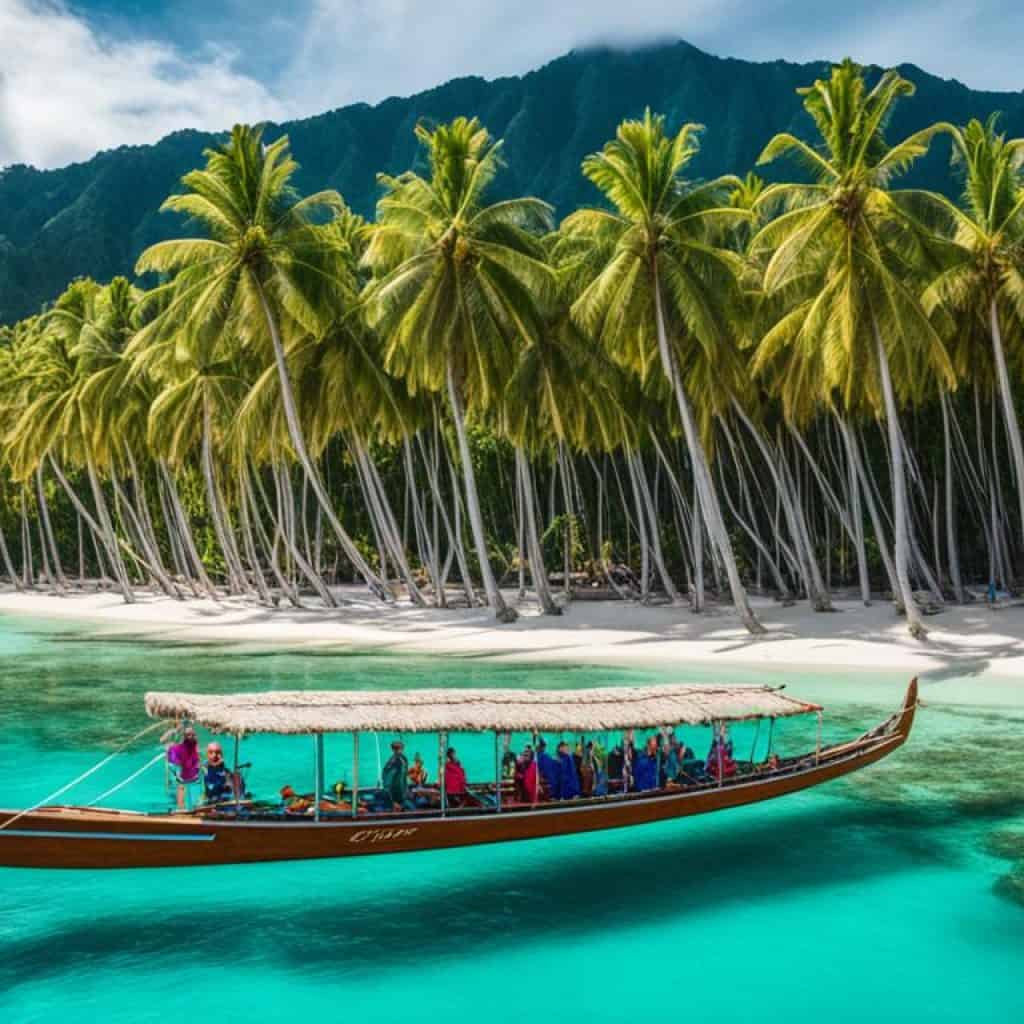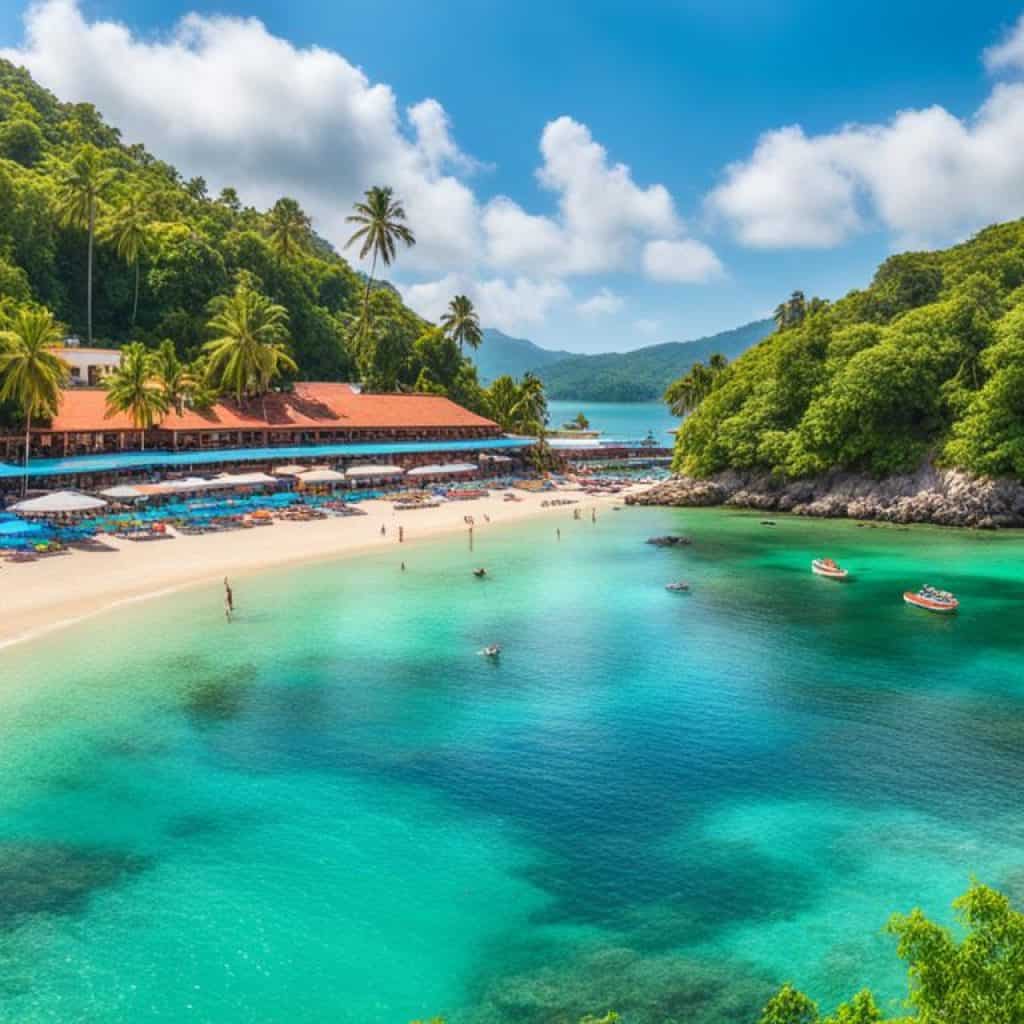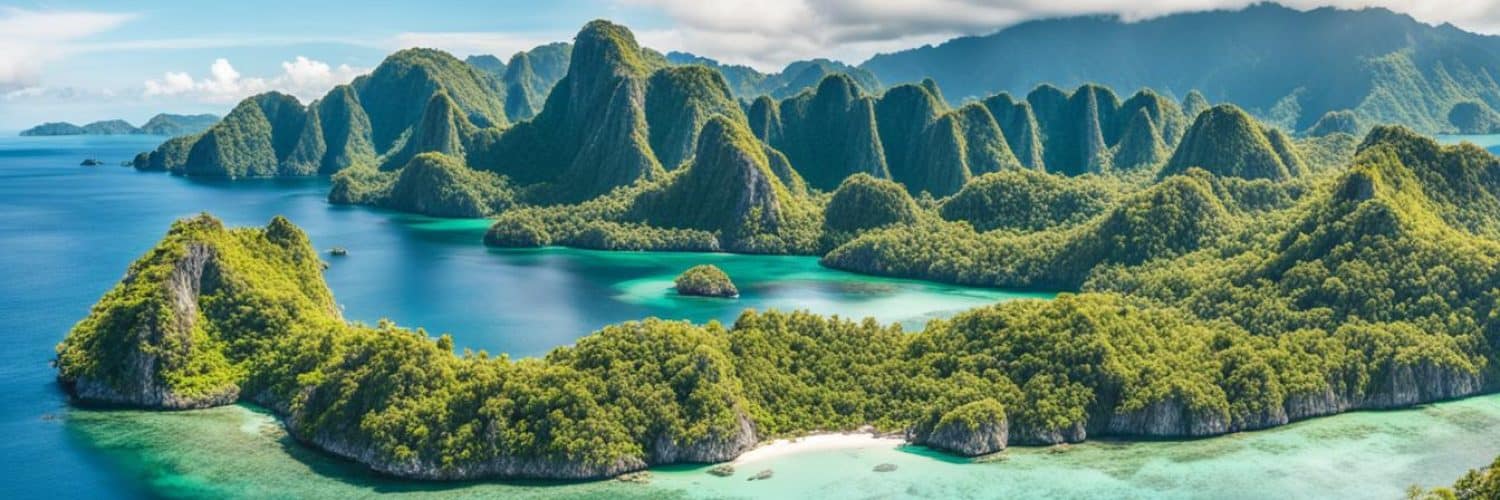Are you ready for an adventure in the tropical paradise of the Philippines? With its breathtaking landscapes, rich cultural heritage, and mouthwatering cuisine, the Philippines offers a truly unforgettable travel experience. But where should you start? How can you make the most of your trip? Don’t worry, we’ve got you covered.
Our comprehensive guide to the Philippines will equip you with essential travel tips, introduce you to the best places to visit, immerse you in Filipino culture, and provide you with a recommended travel itinerary. From the stunning beaches of Palawan to the vibrant city life of Manila, our guide will help you navigate through this diverse archipelago and uncover hidden gems along the way.
Whether you’re a seasoned traveler or it’s your first time in the Philippines, our guide will ensure that you don’t miss out on anything this beautiful country has to offer. So pack your bags, embrace the spirit of adventure, and get ready to explore the Philippines like never before.
Key Takeaways:
- Discover the best places to visit in the Philippines
- Learn about Filipino culture and traditions
- Plan your perfect Philippines travel itinerary
- Explore the diverse cuisine of the Philippines
- Find out the essential travel tips and essentials for a smooth trip
Best Time to Go to the Philippines
Planning a trip to the beautiful Philippines? Choosing the best time to visit can greatly enhance your travel experience. The country has two distinct seasons: the dry season and the wet season. Consider the ideal months to travel, the summer and peak season, the rainy and off-peak season, as well as the vibrant holiday season in the Philippines.
The dry season, which lasts from November to June, is widely regarded as the best time to visit most destinations in the Philippines. During these months, the weather is generally pleasant, with lower chances of rain and more sunshine. It’s an excellent time to hit the stunning beaches, explore the mesmerizing landscapes, and indulge in various outdoor activities without interruption. Additionally, the dry season coincides with the cooler months of December to February, making it ideal for travelers who prefer milder temperatures.
On the other hand, the wet season in the Philippines occurs from July to October. This period brings frequent rain showers and an increased risk of typhoons. As such, it is considered the off-peak season. While it may not be the best time for beach bumming and island hopping, it can be a great opportunity to take advantage of lower prices, fewer crowds, and lush green landscapes. However, it’s important to note that some tourist destinations may have limited activities or services during this time, so be sure to check ahead.
If you’re planning a trip during the holiday season in the Philippines, from November to December, prepare for a festive and lively atmosphere. The country celebrates numerous holidays, including Christmas and New Year’s Eve, with extravagant decorations, spectacular light displays, and vibrant street parades. Many Filipinos travel to their hometowns during this time to spend the holidays with their families, so popular tourist destinations may be bustling with both local and international visitors.
Best Time to Visit Specific Destinations
While the aforementioned general guidelines apply to most of the Philippines, it’s worth considering the specific climate and peak seasons of the individual destinations you plan to visit. For example, the surfing capital of Siargao experiences its best waves from August to November, which corresponds to the rainy season. Similarly, Palawan, with its world-renowned El Nido and Coron, is generally best visited during the dry season to enjoy clear waters for snorkeling and island hopping. Researching the ideal time to visit your desired destinations will help you make the most of your trip.
| Season | Ideal Months | Pros | Cons |
|---|---|---|---|
| Dry Season | November to June |
|
|
| Wet Season | July to October |
|
>Limited activities and services in some destinations |
Geography of the Philippines
The Philippines is a diverse country composed of three main island groups: Luzon, Visayas, and Mindanao. Each group has its own unique characteristics and attractions, offering travelers a wide range of experiences.
Luzon: Located in the northern part of the country, Luzon is the largest island and home to the bustling capital city of Manila. It is known for its vibrant urban scene, historical landmarks, and breathtaking natural landscapes. From the stunning rice terraces of Banaue to the picturesque beaches of Batangas, Luzon offers a mix of cultural and natural wonders.
Visayas: Situated in the central part of the Philippines, the Visayas region is renowned for its pristine beaches and crystal-clear waters. Popular destinations such as Boracay Island, Cebu, and Bohol attract beach lovers and water sports enthusiasts from around the world. Visayas is also rich in history and culture, with charming colonial towns and centuries-old churches.
Mindanao: Found in the southernmost part of the country, Mindanao is characterized by its diverse cultural heritage and natural beauty. This region offers opportunities for eco-adventures, such as trekking in Mount Apo or exploring the unique landscape of the Enchanted River. Mindanao is also known for its vibrant local markets and traditional festivals.
Understanding the geography of the Philippines is essential for planning your itinerary. It allows you to make informed decisions about the destinations you want to visit and the distances between them. Whether you’re seeking bustling city life, pristine beaches, or cultural immersion, the Philippines has something for every traveler.
Geography of the Philippines – Quick Overview
| Island Group | Main Islands | Key Attractions |
|---|---|---|
| Luzon | Mainland Luzon, Batanes, Palawan, Mindoro | Manila, Banaue Rice Terraces, Taal Volcano, Batangas beaches |
| Visayas | Cebu, Bohol, Boracay, Negros, Samar | Boracay Island, Chocolate Hills, Sinulog Festival, Oslob Whale Sharks |
| Mindanao | Davao, Siargao, Camiguin, Zamboanga | Mount Apo, Enchanted River, T’nalak weaving, Vinta Festival |

Arriving at Manila Airport: What You Need to Know
Manila Airport serves as the main gateway to the Philippines, welcoming travelers from all around the world. Navigating the airport and arranging transportation to your destination is an important part of ensuring a smooth and enjoyable trip. Here are some essential things you need to know:
- Manila Airport: Also known as Ninoy Aquino International Airport, Manila Airport consists of four terminals. Terminal 1 is primarily used for international flights, while Terminal 2 serves as the home base for Philippine Airlines. Terminal 3 is the newest and largest terminal and is used by several international and domestic airlines. Terminal 4, also known as the Domestic Terminal, is used for domestic flights.
- Transportation Options: Once you’ve cleared customs and collected your luggage, you have several transportation options to choose from. Taxis are readily available and offer a convenient way to reach your destination. Alternatively, you can book a Grab car, which is similar to ride-hailing services like Uber. Tricycles, jeepneys, buses, and boats are other modes of transportation available for getting around the Philippines. Researching your transportation options in advance can save you time and help you choose the most suitable option for your needs.
Arriving at Manila Airport marks the beginning of your adventure in the Philippines. From this bustling hub, you can embark on a journey to discover the country’s vibrant culture, stunning landscapes, and warm hospitality. Make sure to plan your transportation in advance to start your trip on the right foot.
How to Get Around the Philippines
Exploring the beautiful Philippines requires efficient and reliable transportation. With its diverse geography and numerous islands, getting around the country involves a combination of different modes of transportation.
When it comes to traveling within the Philippines, you have various options depending on your destination:
- Tricycle: These three-wheeled vehicles are commonly used for short-distance trips within towns and cities.
- Jeepney: Iconic and colorful, jeepneys are a popular mode of transportation for both locals and tourists. They operate on fixed routes and are an affordable way to travel in urban areas.
- Bus: If you’re planning to travel between cities or provinces, buses provide a convenient and comfortable option. Choose from air-conditioned or non-air-conditioned buses depending on your preference.
- Boat: With its numerous islands, water transportation is often necessary to explore the different regions of the Philippines. Ferries and boats are available for inter-island travel, offering scenic journeys and the chance to discover secluded island destinations.
In major cities like Manila and Cebu, Grab car services are a popular and convenient choice for getting around. Grab allows you to easily book private cars or taxis using a smartphone app, making transportation hassle-free.
If you’re planning to visit multiple islands, flights are available from major airports, providing a faster way to reach far-flung destinations. Domestic airlines offer regular flights to popular tourist spots, ensuring you can maximize your time exploring.
When planning your itinerary, consider the distances between destinations and the time required for travel. Some areas may require longer travel times due to infrastructure or geographical constraints. It’s important to factor in these considerations to ensure a well-planned and enjoyable trip.
Experience the convenience and adventure of transportation in the Philippines as you explore its stunning landscapes and vibrant culture.

“The joy of traveling is not just reaching the destination but immersing yourself in the journey.”
– Unknown
Hotels in the Philippines
When visiting the Philippines, finding the perfect accommodation can greatly enhance your travel experience. The country offers a diverse range of hotels and resorts that cater to different budgets and preferences. From luxurious beachfront resorts to charming budget-friendly guesthouses, there is something for everyone.
For those exploring Luzon, the largest island in the Philippines, the capital city of Manila is home to a variety of hotels and resorts that provide easy access to key attractions and vibrant city life. Whether you’re looking for a modern high-rise hotel or a boutique property with local charm, Manila has options to suit every traveler’s taste.
If you’re planning to visit the stunning islands and beaches of Visayas, popular destinations like Boracay and Cebu offer an abundance of beachfront properties. Imagine waking up to panoramic ocean views and direct access to powdery white sands. These beach resorts not only provide a relaxing retreat but also offer a range of water sports activities and convenient access to local attractions.
In the southern region of Mindanao, travelers can find a mix of city hotels and nature-inspired resorts. Cities like Davao and Cagayan de Oro offer comfortable accommodations for urban exploration, while places like Siargao and Samal Island provide tranquil beachfront resorts surrounded by lush tropical landscapes.
Theme Hotels and Resorts
If you’re looking for a unique and memorable stay, the Philippines also offers a selection of theme hotels and resorts. From eco-friendly accommodations that promote sustainability to resorts inspired by local traditions and culture, these properties provide an immersive experience for guests.
“Staying at a themed hotel or resort adds an extra layer of excitement and allows you to fully immerse yourself in the destination’s culture and atmosphere. It’s a wonderful way to create lasting memories.”
When choosing your hotel in the Philippines, consider your budget, preferred location, and desired amenities. Whether you’re seeking relaxation, adventure, or cultural immersion, there are hotels and resorts across Luzon, Visayas, and Mindanao that can cater to your needs.
| Location | Hotel/Resort | Price Range per Night (USD) | Features |
|---|---|---|---|
| Luzon | Manila | $100 – $400 | City hotels with easy access to attractions, rooftop bars, and city views. |
| Visayas | Boracay | $150 – $600 | Beachfront resorts, watersports facilities, spa services. |
| Mindanao | Davao | $80 – $200 | City hotels with modern amenities, local cuisine, and proximity to nature parks. |
Whichever region you choose to explore, the Philippines promises a memorable stay with its diverse hotel offerings. Take your time to research and find the perfect accommodation that will enhance your overall travel experience.
Must-Visit Tourist Spots in the Philippines
The Philippines is a treasure trove of must-visit tourist spots that will captivate your senses and leave you with unforgettable memories. Whether you’re a history enthusiast, beach lover, or nature explorer, the country has something for everyone. Here are some of the top destinations that should be on your Philippines itinerary:
Manila: Immerse in History and Culture
Start your Philippines journey in the vibrant capital city of Manila, where history and culture intertwine. Visit the historic walled city of Intramuros and explore centuries-old churches, Spanish colonial buildings, and well-preserved fortifications. Experience the lively atmosphere of Chinatown and take a stroll along the iconic Rizal Park. Manila offers a multitude of museums and art galleries for those seeking a deeper understanding of Filipino culture.
Palawan: Gateway to Paradise
Palawan is a breathtakingly beautiful province renowned for its crystal-clear turquoise waters, limestone cliffs, and stunning coral reefs. El Nido and Coron are popular destinations within Palawan, offering island-hopping tours that will take you to hidden lagoons, secluded beaches, and mesmerizing dive sites. The UNESCO World Heritage Site of the Puerto Princesa Subterranean River National Park is a must-visit for its underground river and rich biodiversity.
Boracay Island: Tropical Paradise Experience
Boracay Island is synonymous with paradise. With its powdery white sand beaches, clear blue waters, and vibrant nightlife, it’s no wonder why it’s a favorite destination for beach lovers and party-goers. Enjoy water activities such as snorkeling, diving, and parasailing, or simply relax under the shade of palm trees. Witness stunning sunsets that paint the sky in breathtaking colors before indulging in delectable cuisine at the island’s numerous restaurants and bars.
Cebu: Nature, History, and Underwater Wonders
Cebu is a province that offers a mix of natural wonders, historical sites, and vibrant city life. Visit the iconic Magellan’s Cross and the Basilica Minore del Santo Niño in Cebu City, which are both significant landmarks in Philippine history. Explore the enchanting Kawasan Falls, swim with whale sharks in Oslob, or dive in the clear waters of Moalboal. Cebu’s proximity to other stunning destinations like Bohol and Malapascua Island makes it an ideal base for further adventures.
Bohol: Pristine Nature and Unique Attractions
Bohol is known for its stunning Chocolate Hills, which are a unique geological formation that turns brown during the dry season. Explore the mesmerizing Hinagdanan Cave, have a close encounter with the adorable tarsiers, and take a relaxing river cruise along the Loboc River. The island also boasts beautiful beaches and dive sites, making it a haven for beach lovers and underwater enthusiasts.

Visiting these must-visit tourist spots in the Philippines will allow you to witness the country’s natural beauty, immerse in its rich culture, and create lifelong memories. Each destination offers its own unique charm and experiences, making for a truly unforgettable Philippine adventure.
What to Eat in the Philippines
Filipino cuisine is a delightful fusion of flavors from various cultures, resulting in a unique culinary experience. When visiting the Philippines, don’t miss the opportunity to indulge in the country’s diverse dishes. Here are some must-try Filipino delicacies:
- Adobo: Marinated meat, typically chicken or pork, cooked in soy sauce and vinegar. It’s a savory and tangy dish that perfectly embodies Filipino comfort food.
- Sisig: A sizzling dish made from chopped pig’s face and ears, seasoned with spices and served with calamansi and chili. Sisig is beloved for its rich and flavorful taste.
- Halo-halo: A refreshing dessert made with a colorful mix of shaved ice, sweetened fruits, jellies, beans, and topped with evaporated milk and leche flan. It’s a delightful treat to beat the tropical heat.
Aside from these well-known dishes, the Philippines also boasts regional specialties that highlight the diverse flavors found across the country. For example, in the Bicol region, try the spicy and flavorful Bicol Express, a dish made with chili peppers, coconut milk, and seafood. It’s an explosion of taste that showcases the region’s love for bold flavors.
The Filipino cuisine guide wouldn’t be complete without mentioning the countless street food options available throughout the country. From skewered meats and fish balls to crispy fried snacks, street food offers a glimpse into the vibrant and bustling local food scene. Don’t hesitate to explore the street food stalls and indulge in these affordable and delicious treats.
Whether you’re a fan of savory dishes, refreshing desserts, or adventurous street food, the Philippines has something to satisfy every palate. Embrace the opportunity to discover the country’s culinary delights and experience the unique flavors that make Filipino cuisine truly unforgettable.
Suggested 2-Week Itinerary in the Philippines
To make the most of your trip to the Philippines, we recommend a 2-week itinerary that covers the best destinations. This itinerary provides a well-rounded introduction to the beauty of the Philippines.
Week 1: Exploring Manila and Palawan
Start your adventure in Manila, the bustling capital of the Philippines. Immerse yourself in the city’s vibrant culture and history by visiting iconic landmarks such as Intramuros, Fort Santiago, and Rizal Park. Experience the blend of old and new as you explore the bustling streets and indulge in delicious Filipino street food.
After a few days in Manila, catch a flight to Palawan, a tropical paradise renowned for its stunning beaches and crystal-clear waters. Spend your time island hopping in El Nido, where you can discover picturesque lagoons, hidden caves, and pristine coral reefs. Don’t miss the chance to visit the enchanting Underground River in Puerto Princesa, a UNESCO World Heritage Site.
Week 2: Beaches, Culture, and Nature
From Palawan, fly to Boracay Island, one of the world’s best beach destinations. Savor the powdery white sands and turquoise waters as you relax on the beach or engage in various water activities like snorkeling, diving, and paddleboarding. Enjoy the vibrant nightlife scene and indulge in mouthwatering seafood dishes that the island is famous for.
Next, head to Cebu, a province known for its beautiful beaches, vibrant city life, and rich cultural heritage. Explore the pristine islands of Mactan and Malapascua, where you can swim with thresher sharks and marvel at colorful coral gardens. In Cebu City, visit historical sites like the Magellan’s Cross and the Basilica Minore del Santo Niño.
Conclude your 2-week itinerary in Bohol, an island province famous for its unique attractions. Discover the mesmerizing Chocolate Hills, cruise along the Loboc River, and encounter adorable tarsiers, one of the world’s smallest primates. Experience the enchanting beauty of the Hinagdanan Cave and relax on the pristine beaches of Panglao Island.
By following this suggested itinerary, you will have the opportunity to explore the vibrant city life, stunning beaches, and rich cultural heritage that the Philippines has to offer. Pack your bags and get ready for an unforgettable adventure!
Discovering Filipino Culture
To truly immerse in Filipino culture, it’s important to learn about the country’s customs, traditions, and festivals. Filipinos are known for their warm hospitality and festive celebrations. Experience cultural events like the Panagbenga Festival in Baguio City, the Sinulog Festival in Cebu, and the Giant Lantern Festival in San Fernando, Pampanga. Take the opportunity to learn about the rich history and traditions of the Philippines during your visit.
Travel Essentials for the Philippines
When planning your trip to the beautiful Philippines, it’s important to consider a few essential items to make your journey smooth and enjoyable. Here are some travel tips and essentials to keep in mind:
- Valid Passport and Visa: Ensure that your passport is valid for at least six months beyond your intended stay in the Philippines. Also, check the visa requirements for your nationality to enter the country.
- Travel Insurance: It is highly recommended to have travel insurance that covers medical emergencies, trip cancellations, and lost or stolen belongings. This will provide you with peace of mind throughout your journey.
- Appropriate Clothing: Pack lightweight and breathable clothing suitable for the tropical climate of the Philippines. Don’t forget to bring swimwear, sun hats, and sunglasses for sunny beach days.
- Mosquito Repellent and Sunscreen: Protect yourself from sunburn and mosquito bites by carrying high-quality sunscreen and mosquito repellent. These essentials will help you stay comfortable and safe during outdoor activities.
- Stay Hydrated: The Philippines can get hot and humid, so it’s important to stay hydrated. Carry a reusable water bottle and drink plenty of fluids to avoid dehydration.
- Be Cautious and Aware: While exploring the Philippines, it’s important to be cautious of your surroundings and keep an eye on your belongings. Stay informed about the local customs and culture to ensure a respectful and enjoyable experience.
By keeping these travel essentials in mind, you’ll be well-prepared for a memorable journey through the enchanting landscapes and vibrant culture of the Philippines.
Famous Quote:
“Travel is the only thing you can buy that makes you richer.” – Anonymous
Conclusion
The Philippines is a diverse and beautiful country that offers a wealth of experiences for travelers. From stunning beaches to historical landmarks, there is something for everyone to explore. This comprehensive guide has provided essential travel tips, highlighted the best places to visit, introduced you to Filipino culture, and recommended a travel itinerary. Whether you’re a nature lover, a history buff, or a foodie, the Philippines has it all.
Use this guide as a starting point to plan your own amazing adventure in the Philippines. Discover the pristine beaches of Palawan, immerse yourself in the vibrant city life of Manila, or indulge in the local cuisine that combines flavors from various cultures. Don’t forget to experience the warmth and hospitality of the Filipino people, who are known for their friendly and welcoming nature.
Whether you’re a first-time visitor or a seasoned traveler, the Philippines has endless possibilities waiting to be explored. Embark on a journey to this tropical paradise and create memories that will last a lifetime. With this guide, you’ll be well-prepared to make the most of your time in the Philippines and have an unforgettable travel experience.


















Add comment